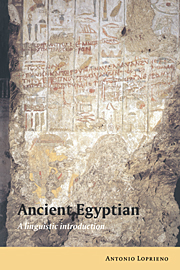Book contents
- Frontmatter
- Contents
- Preface
- Major Chronological Divisions of Egyptian History
- 1 The language of Ancient Egypt
- 2 Egyptian graphemics
- 3 Egyptian phonology
- 4 Elements of historical morphology
- 5 Nominal syntax
- 6 Adverbial and pseudoverbal syntax
- 7 Verbal syntax
- Epilogue
- Notes
- References
- Index of passages
- Index of morphemes
- Index of lexemes
- Index of topics
1 - The language of Ancient Egypt
Published online by Cambridge University Press: 08 December 2009
- Frontmatter
- Contents
- Preface
- Major Chronological Divisions of Egyptian History
- 1 The language of Ancient Egypt
- 2 Egyptian graphemics
- 3 Egyptian phonology
- 4 Elements of historical morphology
- 5 Nominal syntax
- 6 Adverbial and pseudoverbal syntax
- 7 Verbal syntax
- Epilogue
- Notes
- References
- Index of passages
- Index of morphemes
- Index of lexemes
- Index of topics
Summary
The genetic frame
Ancient Egyptian represents an autonomous branch of the language phylum called Afroasiatic in the USA and in modern linguistic terminology, Hamito-Semitic in Western Europe and in comparative linguistics, Semito-Hamitic mainly in Eastern Europe. Afroasiatic is one of the most widespread language families in the world, its geographic area comprising, from antiquity to the present time, the entire area of the eastern Mediterranean, northern Africa, and western Asia.
The most important languages of the ancient and modern Near East – with the notable exceptions of Sumerian and Hittite – belong to this family, which is characterized by the following general linguistic features: a preference for the fusional (or flectional) type; the presence of bi- and triconsonantal lexical roots, capable of being variously inflected; a consonantal system displaying a series of pharyngealized or glottalized phonemes (called emphatics) alongside the voiced and the voiceless series; a vocalic system originally limited to the three vowels /a/ /i/ /u/; a nominal feminine suffix *-at; a rather rudimentary case system, consisting of no more than two or three cases; a nominal prefix m-; an adjectival suffix -ī (called nisba, the Arabic word for “relation”); an opposition between prefix conjugation (dynamic) and suffix conjugation (stative) in the verbal system; a conjugation pattern singular first person *'a-, second person *ta-, third person masculine *ya-, feminine *ta-, plural first person *na-, with additional suffixes in the other persons.
The individual branches of the Afroasiatic family are:
Ancient Egyptian, to which this book is devoted.
Semitic, the largest family of the Afroasiatic phylum.
- Type
- Chapter
- Information
- Ancient EgyptianA Linguistic Introduction, pp. 1 - 10Publisher: Cambridge University PressPrint publication year: 1995



